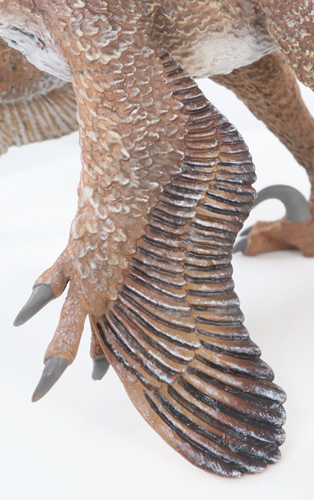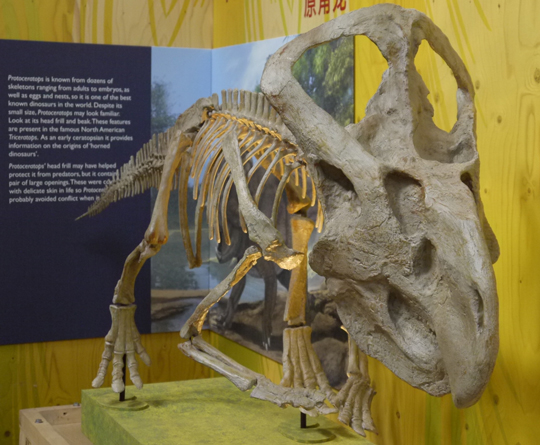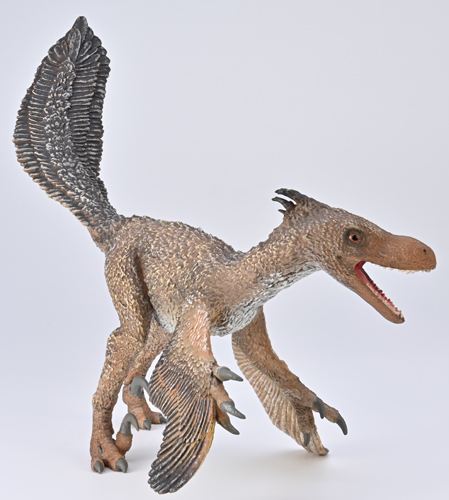Additional Notes on the New for 2024 CollectA Velociraptor
On November 7th, 1924, the American Museum of Natural History published a short, scientific paper written by Henry Fairfield Osborn which described three types of new theropod dinosaur based on fossils from the Djadochta Formation (Gobi Desert). The first theropod documented was Velociraptor mongoliensis. Its description being based on a skull and jaws (specimen number A. M. 6515) along with additional material including the scythe-like second toe claw, although in the paper this was misidentified, it was thought the claw came from a first finger of the hand.

Picture credit: Everything Dinosaur
For dinosaur and prehistoric animal figures: Dinosaur and Prehistoric Animal Figures.
Velociraptor mongoliensis – “Alert, Swift-moving Carnivorous Dinosaur”
Osborn surmised that these fossils represented an “alert, swift-moving carnivorous dinosaur”, hence the genus name Velociraptor which translates as “swift thief” or “speedy robber”. At the time Velociraptor was thought to be a diminutive member of the Megalosauridae. Over the last hundred years, more than a dozen Velociraptor mongoliensis skeletons have been found. As our understanding of theropod taxonomy has developed, these types of dinosaur, the swift lizards, the dromaeosaurs are now known to be very distantly related to the megalosaur family.
The skull was found on August 11th, 1923, by expedition member Peter Kaisen. Ironically, it was found lying alongside the skull of a Protoceratops (Protoceratops andrewsi) and indeed, ever since, these two dinosaurs Protoceratops andrewsi and Velociraptor mongoliensis have been linked together as predator and prey. Perhaps most spectacularly in the remarkable “fighting dinosaurs” specimen that preserves a Velociraptor and Protoceratops locked in mortal combat.
Picture credit: Everything Dinosaur
The New CollectA Deluxe Velociraptor (2024 Release)
Whilst the new for 2024 CollectA Deluxe 1:6 scale Velociraptor does not show signs of an encounter with a Protoceratops, it does reflect Osborn’s original view of this being an “alert, swift-moving carnivorous dinosaur”.
In addition, the figure reflects some of the very latest research into members of the Maniraptora. In 2023, researchers from the University of Tokyo applied a statistical analysis on forelimb structure that demonstrated that dinosaurs like Velociraptor had a propatagium (pronounced pro-pah-ta-gee-um). This is a soft tissue structure that joins the wrists and the shoulders. This structure is seen in living, volant birds. It helps with the wing flapping motion and provides a leading edge to the wing. Without this structure, birds could not fly.
To read Everything Dinosaur’s article about this research: Some Theropod Dinosaurs had a Propatagium.
Why Did Velociraptor have a Propatagium?
Velociraptor could not fly, so why did it have a propatagium? This has been the subject of much debate amongst palaeontologists. Perhaps it had a role in visual display. Perhaps it acted as an additional stabiliser as the animal turned swiftly, or maybe it demonstrated fitness for breeding. It has been suggested that an enlarged surface area of the forelimb would have been beneficial in helping to shade eggs or perhaps it played some other role in the brooding process.
Whatever the reason or reasons for the propatagium, it is great to see CollectA have incorporated some of the very latest research into their commemorative Velociraptor figure.
To view the CollectA Deluxe model range: CollectA Deluxe Prehistoric Life Models.



